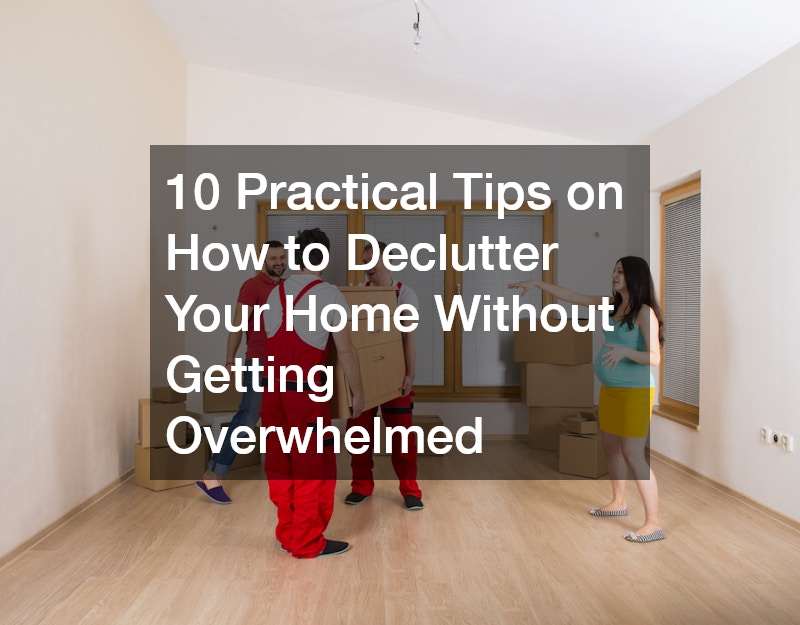Decluttering your home can be a daunting task, especially when you don’t know where to start or how to make consistent progress. But a clutter-free home offers many benefits: reduced stress, improved productivity, and a more pleasant living environment. To help you tackle this seemingly overwhelming task, here are 10 practical tips for decluttering your home without getting overwhelmed.
1. Start with a Plan: Break It Down into Small Tasks
One of the biggest reasons people feel overwhelmed when decluttering is that they try to do everything at once. Instead, break the process down into small, manageable tasks. For example, focus on one room, one closet, or even one drawer at a time. If the room feels too big, start with a single shelf or section of a space.
Set realistic goals, such as spending 15-30 minutes decluttering each day rather than trying to complete everything in one go. This approach makes the task less intimidating and ensures consistent progress.
Tip: A detailed checklist can help. You can even tie this to larger projects like preparing a checklist for selling a house—a neat and clutter-free home can increase its appeal to potential buyers.
2. Use the “Four-Box Method” for Quick Decision-Making
When you’re decluttering, decision fatigue can set in, making the process drag on and feel exhausting. To speed things up, try the “Four-Box Method.”
Label four boxes as follows:
- Keep (for items that you regularly use and have a place for)
- Donate (for items in good condition that you no longer need)
- Sell (for valuable items you want to sell)
- Trash (for things that are broken or unusable)
By quickly categorizing each item, you’ll avoid getting stuck in the decision-making process and move through the clutter faster.
3. Focus on High-Traffic Areas First
Start decluttering areas of your home that you use the most, such as the kitchen, living room, and entryway. These are the spaces where clutter tends to accumulate the fastest, but they’re also the areas where you will see the greatest benefit from cleaning.
Clearing these high-traffic areas first will give you an immediate sense of accomplishment and inspire you to tackle the less visible parts of the home.
4. Declutter for 15 Minutes a Day
You don’t need to devote an entire weekend to decluttering. Instead, set aside just 15 minutes a day. Consistency is more important than marathon sessions.
Set a timer and focus solely on one small area for that short burst of time. This will help you see immediate progress without feeling overwhelmed. Over time, these 15-minute sessions will add up, and you’ll notice a significant improvement in the state of your home.
Statistic: Studies show that breaking tasks into smaller intervals can increase focus and reduce stress. Even just 15 minutes of decluttering daily can lead to a clutter-free home within weeks.
5. Tackle Sentimental Items Last
Sentimental items, such as old photos, keepsakes, or gifts from loved ones, are often the hardest to part with. If you start with these, you are likely to slow down or become emotionally attached, making it harder to declutter.
Instead, begin with practical items like clothes, books, or kitchen gadgets. Once you’ve gained momentum, you can move on to sentimental items with more confidence and a clearer perspective on what you truly want to keep.
6. Go Digital: Reduce Paper Clutter
Paper clutter is a common problem in many homes. From old bills to outdated documents, paper can quickly pile up. Going digital is an excellent way to eliminate this form of clutter.
Sort through your paperwork, scanning important documents and storing them digitally. Shred or recycle anything you no longer need, such as old receipts or outdated forms. Not only will this free up physical space, but it will also make finding important documents much easier in the future.
Tip: Studies from Princeton University have shown that physical clutter, such as paper, can negatively affect focus and productivity.
7. Use a “One-In-One-Out” Rule for New Items
A simple but effective rule for preventing future clutter is the “One-In-One-Out” method. For every new item you bring into your home, get rid of one similar item.
For instance, if you buy a new piece of clothing, donate or discard an old one. This ensures that your possessions don’t multiply unnecessarily, helping you maintain the decluttered space you’ve worked hard to create.
8. Get Family or Friends Involved
Decluttering doesn’t have to be a solo project. Involve your family members, especially if they share the space. Assign tasks to each person based on their capabilities and preferences. You can even turn it into a fun activity by setting challenges or goals for the day.
If family members are reluctant, remind them that a clutter-free home will benefit everyone by creating a more pleasant and organized living environment.
9. Use Checklists to Stay on Track
Having a checklist is a powerful tool when decluttering. It gives you a clear roadmap and ensures you stay on track. For example, create a room-by-room checklist where you can mark off areas as you declutter them.
Checklists are also invaluable if you plan to sell your home. Incorporating a checklist for selling a house ensures your space is ready for potential buyers. A clutter-free, organized home is more likely to make a positive impression and sell faster.
10. Celebrate Small Wins and Progress
Decluttering is a process, and it’s important to celebrate small victories along the way. After you’ve cleared a room or a particularly cluttered area, take a moment to appreciate your hard work.
Reward yourself by enjoying the newly organized space or treating yourself to something small—just make sure it doesn’t add to the clutter! Recognizing your progress will keep you motivated to continue.
Conclusion
Decluttering your home doesn’t have to be overwhelming. By breaking the process down into smaller tasks, using efficient sorting methods like the Four-Box Method, and setting manageable goals, you can steadily declutter your home without stress.
Not only will these tips help you enjoy a more organized, pleasant space, but they can also prepare you for larger projects, such as using a checklist for selling a house. A clutter-free home is more appealing to buyers, helping you sell faster and for a better price. Remember, the key is consistency and patience—decluttering is a journey, not a race.



